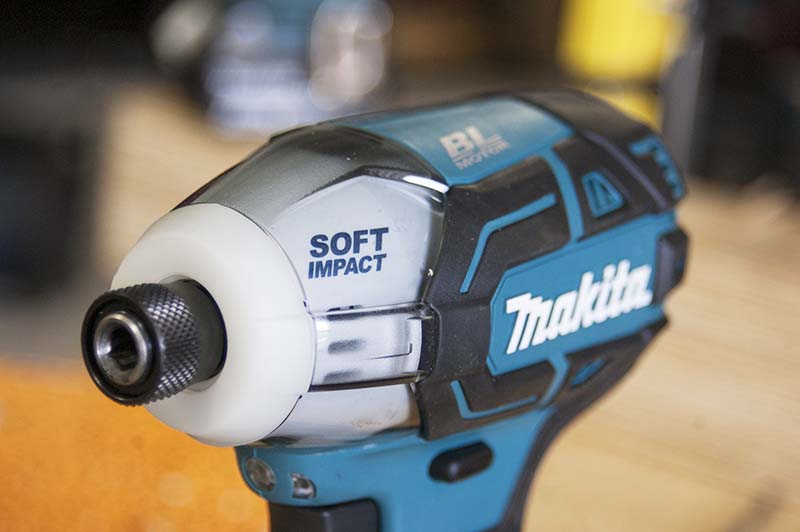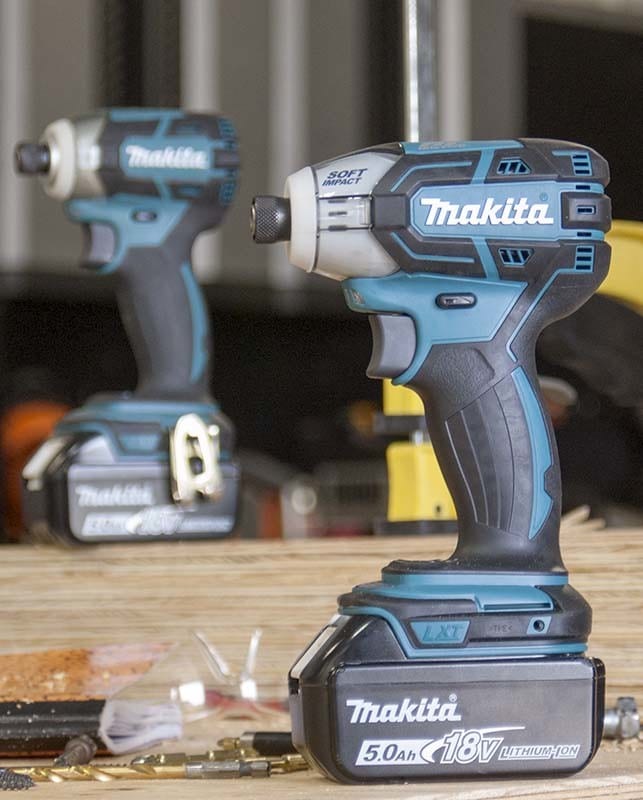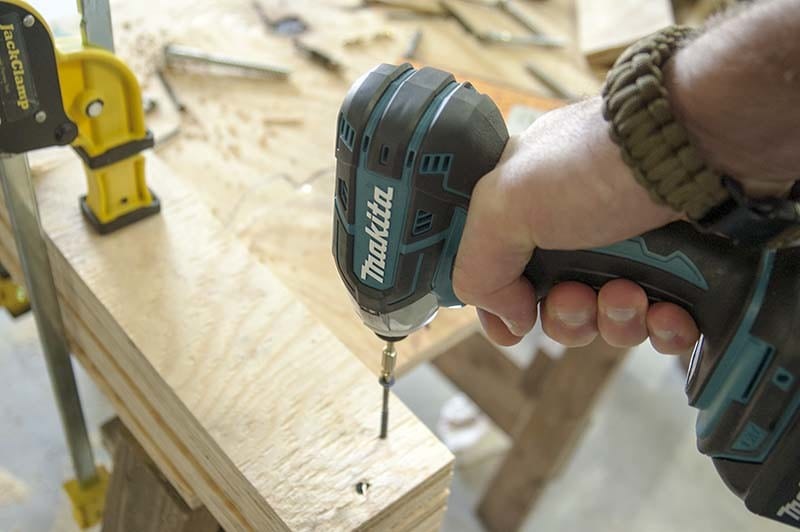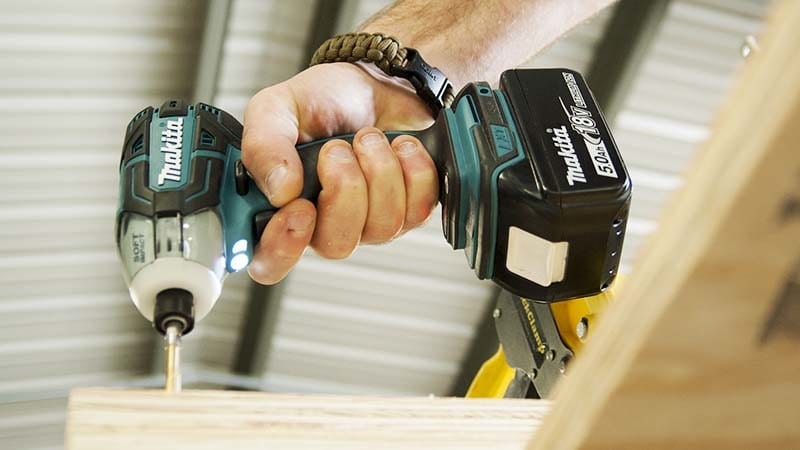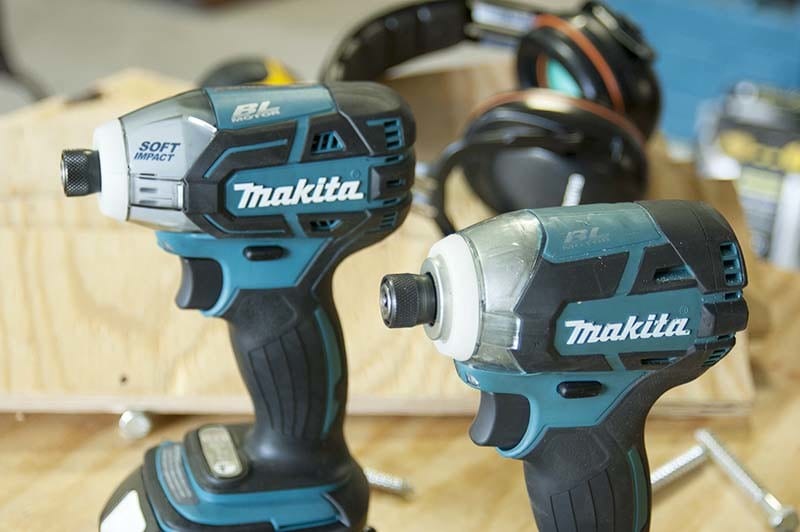We’ve had a couple of sneak peeks at Makita’s latest impact innovation, but now we have the Makita Oil-Impulse Impact Driver in our hands. What’s the big deal about Oil-Impulse technology? Less noise and a slightly different impact mechanism compared to traditional impact driver models. Normally, we expect the hydraulic drive to weigh more than its counterpart, but Makita managed to drop even more weight from their XDT09 Impact Driver that was already the most compact in their entire line.
We’re going to put Makita’s Oil-Impulse through some of the same tests that we use on traditional impact drivers since it’s still an impact driver at heart. We’ll also break out the decibel meter to see just how much quieter the Oil-Impulse technology really is.
It’s that quieter operation making the hydraulic drive attractive to professionals working on jobsites like schools, offices, and apartment complexes. No one wants to try and present last quarter’s profit margin or solve algebraic equations with the pounding of an impact driver on the other side of the wall.
First Impressions
Even though the Makita Oil-Impulse Impact Driver weighs slightly less than the XDT09 Impact Driver, it is longer by 11/16″. Other than the “Soft Impact” printed on the side, you really can’t tell a difference between the driver styles. Even slapping a battery in the slot and turning it on doesn’t make that much of an impression. You can hear a difference in the tone of the sound thanks to the oil, but it’s not that much quieter.
When looking through the spec sheet, things look pretty standard – until you get to the torque. The listed torque is only 355 inch-pounds. Even my 12V drill has more than that!
Before you start to shake your head, the Soft Impact is designed for one thing – screw driving. Larger lag screws and sockets aren’t on the XST01’s diet.
Makita Oil-Impulse Impact Driver Specifications
- Model: Makita XST01Z/M
- Power Source: 18V LXT Lithium-Ion Battery
- Length: 5-3/8″
- Weight (w/5.0 amp hour battery): 3.26 pounds
- Weight (bare): 1.92 pounds
- Published Decibel Rating: 75 dB(A)
- No Load Speed: 1200/2000/3200 RPM
- Impacts: 1400/2200/2700 IPM
- Max Torque: 355 inch pounds
- Included in Kit: XST01Z Oil-Impulse Impact Driver, (2) 4.0 amp hour batteries, rapid charger, belt clip, case
- Warranty: 3 years
- Price: $183.44 (bare tool)
Makita Oil-Impulse Impact Driver Key Features
- Makita BL Brushless Motor
- 3-speed motor with Makita Quick-Shift mode
- Compact, lightweight, and ergonomic design
- Optimized for screw driving applications
Makita Oil-Impulse Impact Driver Performance and Noise Testing
If you saw our best cordless drill article, prepare yourself for an equally epic rundown of current 18V impact drivers in the coming days. With that on the horizon, I decided to use Makita’s XDT09 Impact Driver and the new Makita XST01 Oil-Impulse to make a run through several different tests based on real-world applications. Since the Oil-Impulse is really designed for screw driving duties, that’s what we put it through. We also tested the noise level to truly see how quietly it operates.
Noise Level
Before I could do anything, I needed to cut up some plywood to create my stacked medium for testing. 5 stacked sheets of 3/4″ plywood would give me the thickness I needed to sink 3″ drywall screws. With safety glasses and hearing protection in place, I created 24″ x 4″ strips of plywood. Fastening them together gave me the perfect opportunity to compare numbers with a decibel meter.
I measured the distance from where I would be driving on the workbench to my ear at 28″ as a benchmark for the distance I’d place the decibel meter from me. We decided to test the noise level of screw driving in all three speeds. Makita is basing its noise reduction claims on low speed. Don’t knock it – the goal was to create a tool for applications where noise reduction trumps speed.
Even though their lab testing claims were done at low speed, we found a consistent 8-decibel difference between the two impact drivers.
Makita XDT09 Impact Driver Noise Levels
- Low Speed: 90 dB(A)
- Medium Speed: 96 dB(A)
- High Speed: 98 dB(A)
Makita XST01 Oil Impulse Noise Levels
- Low Speed: 82 dB(A)
- Medium Speed: 88 dB(A)
- High Speed: 90 dB(A)
Makita claims 30% reduced noise, but on the surface, it doesn’t look like the Oil-Impulse is anywhere near that based on these results. We need to dig deeper. Every 10-decibel decrease also drops the perceived loudness by 50%. So the fact that the Makita Oil-Impulse came out 8 decibels lower means that our results exceeded those claims, showing a 40% reduction in perceived loudness at all three speeds.
Screw Driving
I also used the opportunity to get a basic idea of the performance while screwing my plywood strips together. That’s an easy task, but it gave me a really good indication of what the driving experience would be like before grabbing quantifiable data. “Soft Impact” is a great description by Makita. The impact rate was only slightly less than their compact impact driver, but there was a noticeable improvement in how hard the delivered impact felt on my hands, wrist, and arm.
Screw driving with modern cordless tools is fast and I was able to make some comparisons between the XDT09 Impact Driver and XST01 Oil-Impulse. Screw driving is a little slower, but I expected that result. The lower torque and impact rate give it away. Driving twenty-five 3″ drywall screws into 3/4″ plywood took the Makita Oil-Impulse Impact Driver 1:12.90 – which is actually well within the range of the other impact drivers we’re testing for the shootout. Compare that to just over a minute (1:00.52) for the traditional model.
When I tested driving in Makita’s Quick-Shift Mode, I expected a similar experience as the XDT09. The XST01 seemed like it downshifted into mode 1 rather than mode 2 to finish off the drive, which resulted in much slower driving. While this may come across as surprising, it really shouldn’t be as mode 1 fastens at a lower noise level which is the intent of this model’s design.
What To Make of the Results
Don’t assume that Makita’s Oil-Impulse is a direct impact driver replacement at the top of the performance charts – that’s not what it was designed to be. This tool is optimized for screw driving in ways that might not be obvious.
First, forget about lag screws. The XST01 can do it, but it won’t be happy about it. Let’s talk about screw driving. There’s a hidden bonus here from what I experienced in Quick-Shift mode. By dropping down to slow speed so early in the driving process of a 3″ drywall screw, I discovered that you can drive much smaller screws in more delicate material without risking damage to either fastener or material. Woodworkers, are you paying attention? Not only is the noise reduced, but control is improved as well.
Where the XDT09 is a traditional impact driver optimized for a large variety of tasks, the Makita Oil-Impulse Impact Driver is a screw driving specialist that is going to deliver precise, clean results. It’s also going to do it in style with less noise, softer impacts, light weight, and excellent ergonomics.

